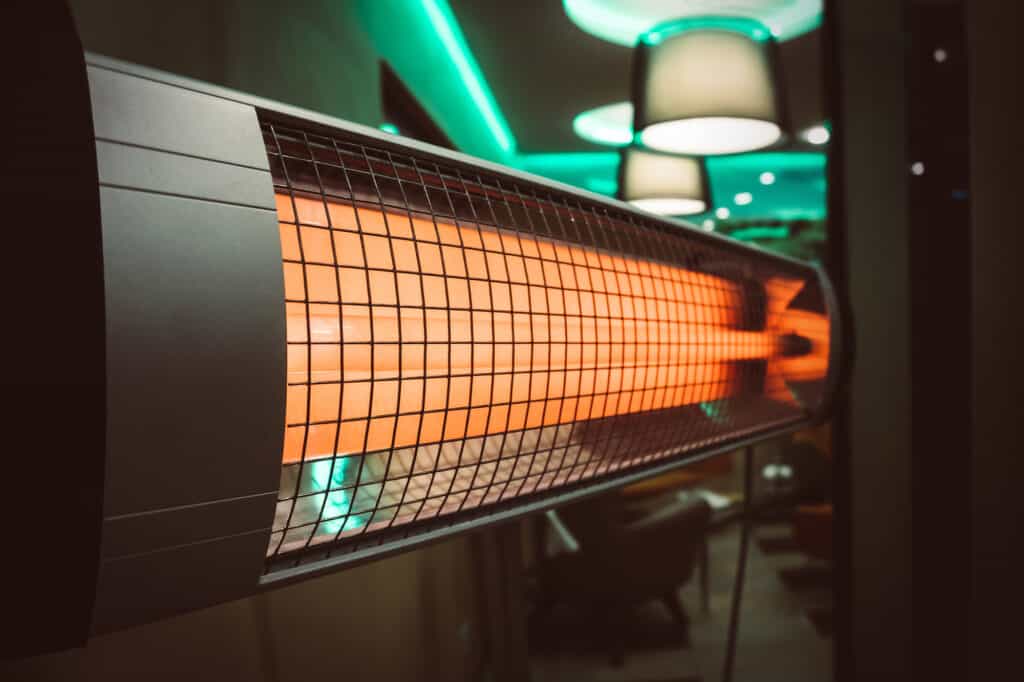You can use some electric patio heaters indoors, with some even made to be indoor/outdoor. But there are still some precautions for ensuring safety.
Electric patio heaters are a safer alternative to gas patio heaters, which is why many homeowners prefer them.
Electric patio heaters can be mounted in various positions, giving many options to heating your space.
Many electric patio heaters can be used under patios, gazebos, or ceilings.
Homeowners may wonder if they can use outdoor electric patio heaters indoors during heating outages or cold days.
Outdoor patio heaters fueled by propane or gas are designed for outdoor use since they can be dangerous due to the risk of carbon monoxide poisoning.
Electric patio heaters work similarly to other indoor heating devices and some models are safe for overnight use with fewer risks.

Related Reading: Do Gel Fuel Fireplaces Produce Heat?
Table of Contents
Using Electric Patio Heaters Indoors
Electric patio heaters are a popular choice for heating screened-in porches and patios during colder months, allowing people to enjoy the outdoors.
There are a few precautions, however, to ensure an electric patio heater indoors remains safe:
- Always stay near the heater as it can cause a fire if left unattended, especially if it falls or is dismounted.
- It is important to follow the recommended distance for heaters, especially for flammable materials such as carpets or chairs. A typical protocol for distancing is around two feet from the ceiling and walls.
- It is not recommended to mix water and liquids, even if the device is waterproof.
- Electric patio heaters should be turned off when not in use to save electricity, which is easy to do with their simple on/off switch.
If you plan to use an electric patio heater indoors, such as in a kitchen or living room, it is recommended to use a patio heater stand.
This will help you position your electric patio heater safely away from walls, ceilings, and floors.
How Do Electric Patio Heaters Work?
Electric patio heaters emit short-wavelength infrared radiation that heats objects in front of them.
They are effective because they do not warm the air. Instead, the heat travels through it.
They warm the objects that the short waves come in contact with.
Electric patio heaters function similarly to the sun, making them effective in winter.
This is what gives electric patio heaters an advantage.
They can effectively warm you up even on windy days and begin working almost instantly when turned on. Plus, they’re great for heating areas like tents during overnight hikes.
Can Outdoor Gas Patio Heaters Be Used Indoors?
There are several safety concerns with gas patio heaters being used indoors.
Their heat is produced from combustion, which can release harmful pollutants to health and the environment.
- carbon monoxide (CO)
- nitrogen dioxide (NO2)
Gas-powered patio heaters may be too powerful for indoor use in small rooms.
Gas-powered patio heaters are also more prone to wear and tear.
This means that if you are not properly inspecting and maintaining an appliance, or if it malfunctions, the risk of pollutants that can harm your health increases along with other safety concerns.
Here’s an RV-safe small prone heater that passed the fire department’s test.
This is an example of a small propane heater used in an RV.
It is recommended to use an electric model patio heater indoors to minimize risks associated with indoor patio heating.
Continue Reading: How To Choose An Electric Patio Heater [FOR THE OUTDOORS]
Final Notes
There are several advantages to using electric patio heaters as compared to gas-powered ones.
Make sure to select an appropriate patio heater for the size of your outdoor space.
Electric patio heaters are an efficient choice for outdoor heating and are popular for partially enclosed spaces like patios and gazebos.
Avoid using gas heaters indoors or partially indoors, especially if an electric model is available.
By doing this, you can concentrate on what truly matters and enjoy a moment of relaxation.
Enjoy living the outdoor life!!!
